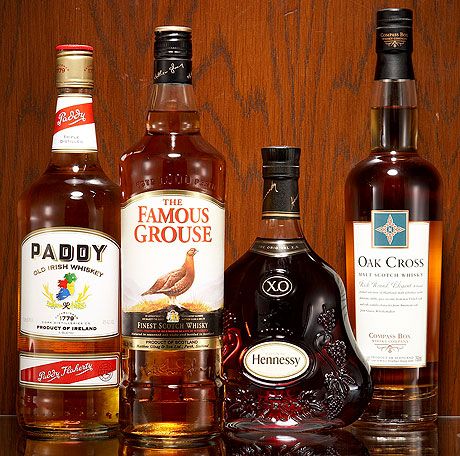Blended Whiskey Brands – What Is Blended Whiskey?

F. Martin Ramin/Studio D
Whiskey labels tend to feature a host of tricksy little terms such as “fine,” “old,” and “smooth”; “small batch,” “family reserve,” “pot stilled” (see our explanation), and “handcrafted.” You’ll often find “blended” or “a blend” lurking among them. Unlike the others, though, that one — as slippery as it sounds — has actual legal meaning. Unfortunately, it’s not always the same legal meaning: Not all blends are created equal.
American blended whiskey, for instance, is made by cutting good rye or bourbon with a mix of water and grain-neutral spirit filtered to flavorlessness. It is thus whiskey-flavored vodka, and we will speak of it here no more. In Scotland, the column-stilled “grain whisky” you blend in with your rich, pot-stilled malt whisky isn’t filtered and has to spend as long in the barrel as the good stuff it’s blended with, so it actually tastes like something. Thus even in the case of a good blend such as Johnnie Walker Red or the Famous Grouse ($22), the most popular “blended whisky” in its homeland, you end up with some depth of flavor. The Grouse, for instance, is appealingly floral and bright in the nose and appreciably richer on the palate than its American cousin. In Ireland, the rules are more or less the same, but there are some interesting wrinkles. Take Paddy’s ($30), for example, which blends not two kinds of whiskey but three: grain whiskey, malt whiskey, and a pot-stilled whiskey made from mixed grains. It’s grassy with angel-food-cake barley sweetness. You could sip it all day long.
But what if you just mix different types of pot-stilled whiskey together and leave out the filler? We used to do that here, but no longer, and more’s the pity. In Scotland, though, they call these “blended malts,” and they can be spectacular, combining the strengths of already wonderful whiskies. Compass Box Oak Cross ($50) combines barrels from at least three different Highland distilleries and then ages that blend for a whisky with a heady, spicy aroma cushioned by a buttery body. Now we’re getting somewhere.
To really see where the blender’s art can lead, though, you’ve got to jump categories over to cognac. The major cognac houses have stocks of unblended, pure pot-stilled brandy going back 200 years, and that’s no exaggeration. For their premier blends — almost all cognac is blended — they’ll combine literally hundreds of brandies, each distilled from grapes of a different terroir and aged differently, to achieve a final product that combines the most interesting aspects of each. No whiskey producer we know of has the stocks of old barrels or for that matter the patience to do this. But taste a cognac like the Hennessy XO ($150), which is a blend of brandies up to 30 years old, and you’ll see the potential this approach holds: It’s fresh and juicy while at the same time spicy, leathery, chocolaty. It gives blending a good name.






